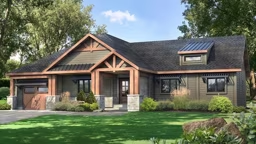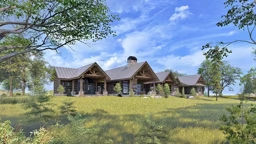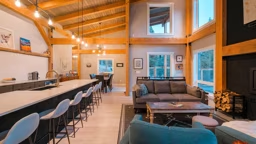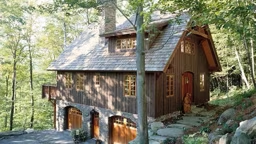
Have you ever walked into a house that instantly put you at ease? Maybe you can’t quite put your finger on why, but there’s something about it that is warm, welcoming and intuitive. More than likely, that feeling is a direct result of “flow.”
Flow is crucial to designing a floor plan that works, and while it does take some thought, it’s not hard. The concept centers around the idea of arranging spaces in a way that makes sense, both to you and to those who are visiting your home. To get it right, consider everything from the view you want to capture to the way you’ll use each room in the house. Here’s how.
1. Start with your location and your landscape.
Your site is the driver behind the design-bus wheel. Before you get on the floor plan road, you first have to check the map and pinpoint any potential blockages to your plans. Look at the things that will constrain or enhance the way you organize the house. If you have an amazing view of snow-capped mountains or a tranquil lake, you’ll want to set the home around that focal point, perhaps by creating a linear design that will provide spectacular panoramas from every room. On the other hand, if your house will be nestled deep within a forest without a soaring view, the rooms will tend to look in on each other, so the design becomes more about the line of sight from one room to another than it is to the outside environment.
2. Draft a design you can live in.
The best way to create a plan that translates into a satisfying home is to envision yourself jumping into the design and moving around in it. How will it look and feel? What sounds will you hear? How will the flow affect everything from daily life to holiday gatherings?
This is probably the most important thing you can do to help determine where rooms should reside inside your floor plan — and that extends to utilitarian spaces.
For example, there’s a great debate on the ideal location for a laundry room. Historically, the washer and dryer were sequestered in a corner of the basement. Fortunately they’ve been elevated from that lowly position, which means you now have a choice to make on its location. Should you put the laundry near the primary suite — even inside a walk-in closet? This is where clothes belong after all. Or, for ultimate multitasking, should you site the space near your kitchen, so you can cook and do laundry at the same time? Or how about a dedicated mudroom next to the garage, so grimy duds won’t be tracked through your pristine home?
This is an example of one of those design edicts that only you (and your daily habits) can determine, but there is one more thing to factor in: It’s important to plan not just for your current situation, but also for the future. In addition to the location of the laundry, make sure you’ll have easy access to the bedroom (main floor owners’ suites are ideal), that you can navigate around the kitchen smoothly (widen walkways between appliances, islands and cabinets) and that you can access all the fixtures in the bathroom (extra-wide doorways, curbless showers and wall-mounted sinks all ensure an easier go of it later in life).
3. Ignore labels.
Resist the urge to pigeonhole your rooms with labels, like “kitchen,” “dining room” or “living room.” Instead, think of them in terms of their function, such as “cooking,” “sleeping” or “family time.” In doing so, you’ll be better able to consider how each space may impact the flow of your overall floor plan. Plus, you just may find that you can reduce your overall square footage and reallocate the money you save toward upgraded materials or special extras you didn’t think you’d be able to afford.
4. Be your own guest.
True — you will be enjoying life in your new timber home more than anyone else, so it must meet your needs first and foremost. That said, you should give a fair amount of consideration to others who might be using it, too, because how they move through the home will affect you as well.
For example, if you’re the type of person who loves to entertain, think about additional public spaces you can add to your plan — such as a screened-in or covered porch, a sunroom or conservatory. At a minimum, a dedicated guest bathroom — usually a main-level powder room — is essential.
If hosting overnight guests is a scenario you anticipate, you’ll want to ensure everyone’s comfort. This doesn’t mean you have to design your house like a small hotel, incorporating guest room after guest room that will be nothing more than wasted space when not in use. Instead, opt for flexible spaces — bedrooms that can easily double as home offices, hobby spaces, game rooms, reading rooms — wherever your interests lie. When drafting your floor plan, be sure to position and design them in a way that is convenient for all their potential functions.
Here’s where the “flow factor” really comes into play. In a timber home, it’s common to walk through the front door to find an impressive, open great room highlighted by exquisite, exposed wood and majestic timber trusses. But there are many subtler design decisions that can have just as much impact on a home’s overall atmosphere.
The two most important organizational principles in floor plan design are the public zones and the private zones and their orientation to each other. How you delineate those very different living areas can have a major impact on the flow of your house. The best example? Hallways.
When you have a lack of hallways — a front door that enters right into the great room or a primary bedroom with a door in the wall of the great room — it sets a very informal tone. In addition to taking you from point A to point B, employing hallways into your design can create an aesthetic and emotional separation, one that can take your place from a cottage getaway to a full-time residence.
However, for modern homeowners — especially those with downsizing on their minds — hallways can feel like a waste of space. They also can trap views and give a small-scale home a claustrophobic feeling. The key is to find balance between creating privacy, maximizing every inch to its fullest and devising a layout that flows effortlessly from room to room.
5. Keep an open mind.
Don’t feel that you have to have it all figured out before you speak with a designer or architect. Professional advice is invaluable through the timber home design process; however, it helps to be prepared when you consult with them.
Communicate your wants-and-needs list clearly, and bring examples (e.g., photos, Pinterest boards, sketches, etc.) so that there’s no room for misinterpretation. You don’t have to be an artist to diagram the flow you want your home to have.
While you’re crafting the layout with your designer, be prepared for a little give and take. Professional architects and draftsmen understand elements of design that laypeople don’t know to consider. They are prepared to steer you in the right direction to a floor plan you will love.











